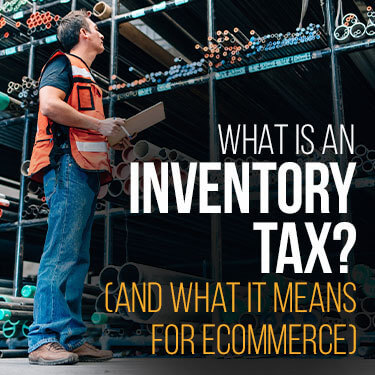
 Copy URL to Clipboard
Copy URL to Clipboard
Inventory taxes are yet another item to check off when managing a business. Taxes can be confusing when you’re just calculating your own. Calculating the taxes involved in running a business adds a new level of complexity. The rise of eCommerce, which often operates entirely online, continues to raise even more questions. So what is inventory tax and what does it mean for eCommerce?
An inventory tax is a property tax applied to a business based on the value of its inventory. It is typically referred to as a business tangible personal property tax (TPP). Inventory tax is based on the state in which you store your inventory, not in the state where your eCommerce business is registered.
Whether you conduct your business online or through brick-and-mortar stores, learn more about how inventory tax can affect you.
Inventory taxes are classified in the same column as property tax. It is a tax imposed on a company’s unsold stock at the end of the year. Inventory is taxed within the same bracket as furniture, tools, and/or equipment belonging to a business. They must also be paid regardless of any profit made.
For struggling businesses, especially those whose inventory has been impacted by pandemic buying practices, it makes operating costs more expensive.
Inventory can also include more than just your finished sale product. If you import raw materials or parts for assembly, these are also included.
The value of your inventory determines the tax levied against you. The Internal Revenue Service (IRS) accepts three different inventory valuation methods:
The best method of calculation is determined by your business practices. If you have a smaller, limited-variety inventory, calculating based on cost is easier. The second and third options provide more flexibility in the case of rising or falling price changes.
However, the value of your inventory also depends on how you manage it. Economic considerations, such as inflation, play a role in valuation.
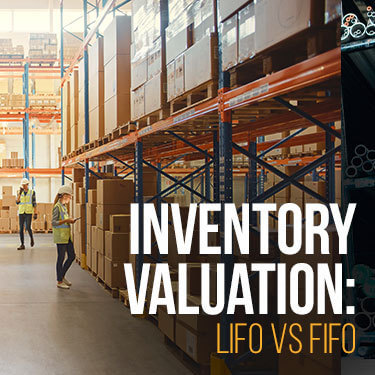
Two basic methods for calculating inventory valuation are FIFO (First In, First Out) and LIFO (Last In, First Out). When companies are managing their inventory, these two terms reflect how they will distribute their business inventory. They also play a role in determining inventory tax rates.
Inventory itself is calculated according to a simple formula. The value of the items determines the ending value balance. Inventory is meant to be valued using its purchase cost. Let’s see how it works with an example using an imaginary company, ABC Articles, with simplified numbers.
To start, we’ll take the beginning inventory (BI), plus the net purchase amount, minus the cost of goods sold (COGS). This will give us the ending inventory (EI).
| Beginning Inventory (BI) | $200,000 |
| Net Purchases | +$150,000 |
| Cost of Goods Sold (COGS) | -$170,000 |
| Ending Inventory (EI) | $180,000 |
Based on the factors above, at the end of the year, ABC Articles will have an inventory valued at $180,000. That would be the amount that determines their inventory tax.
Companies that are using a LIFO system will sell newer items first (last in, first out). Older inventory will be left behind. Most companies simply can’t afford to hold on to stock that will expire. There are some benefits though.
In a LIFO system, the most recent goods will determine COGS, making it higher. The EI will be valued lower because they are based on older items. The net income will also be lower as a result. None of that sounds too good until you also consider that a lower net income and ending inventory valuation will place your company into a lower tax liability.
See how another set of basic data shows that for a month’s calculation of inventory.
| Stages of Inventory | Original Purchase Price | Inventory Value |
|---|---|---|
| Beginning Inventory | 3 articles @ $3 per | $9.00 |
| Purchases on day 8 of month | 4 articles @ $4 per | $16.00 |
| Purchase on day 20 of month | 7 articles @ $6 per | $42.00 |
| Cost of Goods Available | 14 articles | $67.00 |
| Articles sold during month | 10 articles |
If you use LIFO to manage your inventory, the 10 articles sold were the ones valued at $6.00 and $4.00. The remaining 4 items in your inventory would be valued at their original, lower purchase price.
Three articles @ $3 per article + 1 article @ $4 per article = $7 of ending inventory valuation
| Beginning Inventory Value | Day 8 Purchases | Ending Inventory Valuation |
| 3 articles @ $3 | 1 article @ $4 | $7 |
The tax you would be required to pay would be lower, but long term you may get stuck with inventory you can’t unload.
The majority of companies use a FIFO system that uses a First In, First Out management system. Using FIFO, a company is less likely to get stuck with older items in the inventory. Business owners will also have a more accurate representation of value because inventory is more likely to reflect the current market.
The net income will generally be higher because the COGS will be lower. Greater profits will also mean higher liability for that tax year.
Using the same data from above, we can calculate ending inventory if ABC Articles used FIFO for inventory management.
The 10 articles sold would be the ones valued at the lower rate. The remaining 4 articles would be calculated using the value of the last items added.
4 articles @ $6 per article = $24 of ending inventory
| Day 20 Purchases | Ending Inventory Valuation |
| 4 articles @ $6 | $24 |
With a higher valuation of ending inventory, your tax liability also gets higher. However, your company is also less likely to have waste products stuck on shelves that you can’t sell, or must sell below their original purchase value.
Both management systems have pros and cons. How you manage your business, including the inventory, should take into account more than just the tax return. Being aware of how inventory affects taxes is good, but it should not be a guiding light for your entire business plan.
The best tax advice for a business is to practice sound strategies, invest in good management systems, and sell products that people want to continue buying.
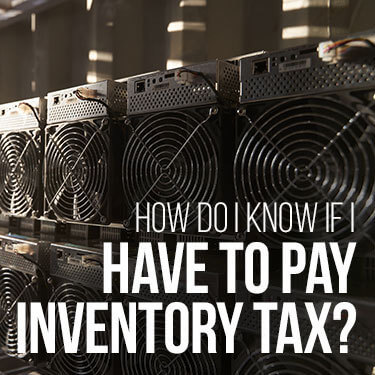
Before you start changing any aspect of your inventory management system, you need to know that not every state considers inventory to be part of a business's taxable income. Inventory tax is a state or local government tax, not a national requirement.
To be taxed, the state must first label inventory as tangible personal property. This allows it to fall under the greater category of a Business Tangible Personal Property (TPP) Tax which covers the goods or properties needed for a business to run.
Items that fall under TPP may include:
States that include inventory as part of TPP will have some form of inventory tax in place. For some states, inventory is taxed at the state level as part of state income tax. In other cases, it depends on the municipality or county where a business keeps its inventory.
The states that track inventory tax, either state-wide or partially are:
If you keep inventory in one of these states, see a tax professional to determine exactly how they calculate inventory tax. States don’t provide any sort of automatic calculator. Business owners are responsible for inventory tracking, valuation, and tax calculation.
Keeping your business compliant with local tax laws matters just as much as federal-level compliance.
However, If your online store sells physical products, some kind of warehouse system is in place for order fulfillment and distribution. How you handle inventory management, warehousing, and distribution plays a significant role in how eCommerce taxes are handled.
Planning out taxes for an eCommerce business is especially tricky because many have no physical location. If you are operating your eCommerce business from a home office, you might already work these into your business expenses.
Inventory tax is based on the state in which you store your inventory, not in the state where your business is registered.
Just because your business is registered in a state that does not have an inventory tax does not mean you have avoided it entirely. Reducing inventory tax isn’t quite as simple as just avoiding states that have it though.
Here are a few different scenarios.
These scenarios show just some of the complexities of calculating inventory tax. How you choose to fulfill orders and where your inventory is kept in the meantime makes a difference. In each of the three cases above, inventory tax can get calculated differently.
Other factors that may affect inventory tax for eCommerce businesses or brick-and-mortar stores are:
Whether a state counts inventory as TPP or not, tax rules surrounding eCommerce business practices continue to evolve. Getting the help of experts to make sure you are covering your bases may prevent unexpected tax hits.
There are no tax deductions on inventory itself. Inventory is considered to be a business asset, so it cannot be expensed. This holds true whether you keep inventory in a state that has inventory tax or not.
The storage space of your inventory may qualify for tax deductions if you use your home residence.
To file a form for a deduction based on storage you must meet certain qualifications:
You may not be able to save on inventory tax if you live in a state where it’s applied, but it may help in other ways. Of course, depending on the scope of your business, this may not be possible. Whatever decision you come to, consider the long-term viability options.
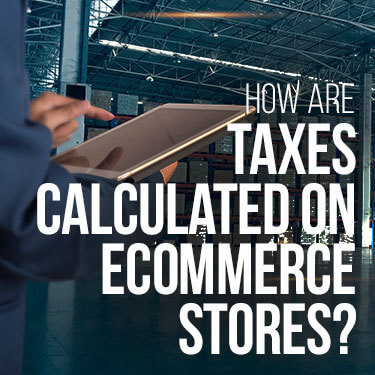
Like any registered business, eCommerce must pay taxes on net income. If the company has brick-and-mortar stores alongside an online platform, the physical location must have a system in place for collecting the sales tax required in the area. This determines the taxes charged to customers.
Laws determining the exact taxes owed by eCommerce businesses for inventory, sales, or specialized items continue to be a matter of debate. The majority of these debates stem from the fact that every state has different tax laws, especially for sales tax. Some states have no sales tax. And again, some states have different tax laws per county.
In short, it can give even the best tax accountants a headache.
Early eCommerce businesses were a bit like the wild west - many just did their own thing and tried to cover their bases as best they could. Few specific laws were in place. Some sites charged a sales tax based on where the business was registered; others didn’t charge any if the products were sold to out-of-state buyers.
As eCommerce grew in popularity, so to did the number of tax issues that needed to be solved. A supreme court case in 2018, South Dakota v. Wayfair, attempted to settle the debate on sales tax.
Before this case, a business had to have a physical presence in a state before sales tax or use tax could be demanded. This could be in the form of a physical store, inventory, or employees. Without that physical presence, there was no definitive way states could force a company to pay sales tax.
For example, a resident of New York could buy clothing from an online retailer in Florida without paying New York sales tax (4% - 8.875% depending on county). The online store would charge a tax, but for income tax purposes, not for state sales tax.
The supreme court ruled in favor of South Dakota. Even if a business does not have a physical presence in the state, sales tax can still be charged on purchases made from out-of-state sellers. This set a new precedent for every other state.
If the sales tax is 8% on a $20 shirt, the state was losing the $1.60 per shirt before the South Dakota v. Wayfair case. One shirt may not seem like much, but continue multiplying it and states were losing out on a significant amount of revenue. Brick-and-mortar stores were also finding it harder to compete with online retailer prices.
| Item | Sales Tax Rate | Tax Owed | Total Cost |
| 1 shirt @ $20.00 | 8% | $1.60 | $21.60 |
| 20 shirts @ $20.00 | 8% | $32.00 | $432.00 |
The decision seems to have evened the playing field between physical stores and eCommerce stores. Although some online retailers, like Amazon, had already begun to incorporate sales tax into their pricing, it has since become a requirement for all.
As online stores continue to expand, tax laws are sure to continue evolving. Working with professionals for tax advice and logistics may help your business navigate these changes.
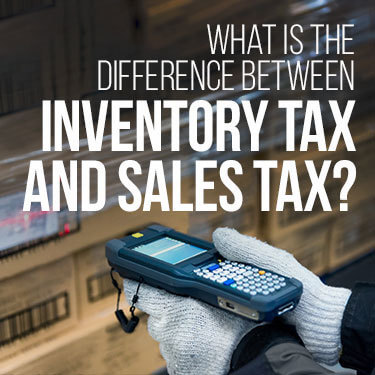
Inventory tax must be paid by the business owners on items that remain unsold at the end of the tax year. The tax is calculated based on the original purchase value, not on how much your business sold it for. Each state that charges inventory tax determines what percentage of inventory value must be paid.
Sales tax is paid by the buyer when purchasing taxable items. Although it is the retailer who adds the sales tax to the price of an item, it does not factor into company profits. A business is required to pay that money back to the state for which it applies.
The amount of sales tax added to an item depends on where the purchaser lives. As mentioned earlier, each state sets its own sales tax rate. Additionally, each state varies on what they consider to be taxable items.
In Alabama, buyers pay the general sales tax on groceries, but buyers in Florida do not. Similar differences can be found when comparing all fifty states.
Since eCommerce businesses are now required to pay state sales tax, business owners need systems in place to handle transactions in multiple states. The conditions under which a state will enforce sales tax remittance from online retailers also vary.
Depending on the type of eCommerce you are managing, there may also be sales tax exemptions you can apply for. Tax laws differ between B2B and B2C sellers.
In short, there are many variations and exemptions which are also continually being adjusted.
States wishing for online retailers to pay state sales tax must show that the company has sales tax nexus. A nexus implies that the company has a “significant connection” to the state.
This begs the question: what qualifies as a “significant connection”? For which the answer is: it will vary from state to state. Hence the continued difficulties faced by eCommerce businesses who are just trying to stay in compliance.
It's a bit like playing pin the tail on the donkey, except the donkey is always getting moved around while more keep popping up and disappearing at random.
Thanks to South Dakota v. Wayfair, all states can now require online retailers to pay sales tax, but some states enforce it more than others. California, for instance, is considered to be the toughest enforcer of state sales tax.
That being said, consider some guidelines for what might be considered a tax nexus:
Keep in mind, this is not a definitive list. All or none of these may apply in states where you are doing business. As your business expands to other states, keeping changing tax laws in place must be a priority.
Don’t get overwhelmed by the different laws and regulations surrounding the question of what is inventory tax? If you want your eCommerce or brick-and-mortar business to be successful, partner with the right people.
R+L Global Logistics has been helping customers manage their inventory, complete their fulfillment needs, and more. Our leaders have decades of experience and can provide the tools you need to keep growing your business.
When it comes to inventory management, we offer 3PL warehouse services designed to maximize efficiency while granting you peace of mind.
Get in touch with us today for a services quote and speak with experts to guide you and your business into the future.
